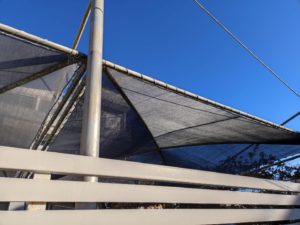Using shade nets offers several advantages across various applications:
Shade nets advantages
16 reasons to use right
- Sun Protection- Parking spaces : Shade nets provide effective protection from the sun’s harsh ultraviolet (U

- V) rays, reducing the risk of skin damage and other health issues caused by prolonged exposure to sunlight.
- Temperature Regulation: Shade nets help regulate temperatures by reducing the amount of direct sunlight that reaches an area. This is especially useful in outdoor spaces, such as patios, gardens, and recreational areas, where they can create a cooler and more comfortable environment.
- Plant Growth: In agriculture and horticulture, shade nets are used to create optimal growing conditions for plants. They can regulate light intensity, prevent excessive heat stress, and control moisture levels, promoting healthier plant growth.
- Energy Savings: By reducing direct sunlight and heat exposure, shade nets can contribute to
- energy savings by lowering the need for air conditioning and cooling systems. This is particularly valuable in buildings and greenhouses.
- Protection Against Hail and Wind: In addition to providing shade, some shade nets are designed to offer protection against hail and strong winds. They can prevent damage to crops, vehicles, and structures during severe weather events.
- Privacy: Shade nets can be used to create private and secluded areas in outdoor spaces, making them suitable for homes, resorts, and commercial establishments.
- Event Spaces: Shade nets are commonly used in outdoor events such as festivals, fairs, and concerts to provide shade for attendees and performers, enhancing the overall experience.
- UV-Sensitive Materials: Shade nets can be employed to protect UV-sensitive materials, such as artwork, furniture, and equipment, from fading and deterioration caused by sunlight exposure.
- Livestock and Poultry: In agricultural settings, shade nets can offer shelter and comfort to livestock and poultry, preventing heat stress and improving their well-being.
- Construction Si
- tes: Shade nets are used in construction to provide shade and protect workers from direct sunlight, creating a safer and more comfortable work environment.
- Aesthetic Enhancement: Shade nets come in various colors and patterns, allowing for creative design choices to enhance the aesthetic appeal of outdoor spaces.
- Erosion Control: In landscaping and environmental applications, shade nets can help control soil erosion by reducing the impact of heavy rain and wind on bare soil.
- Greenhouse Use: In greenhouses, shade nets can help control light intensity and temperature, ensuring optimal conditions for plants while protecting them from excessive sunlight.
It’s important to select the right type of shade net with the appropriate level of shading and durability for your specific needs. The advantages offered by shade nets make them versatile tools for creating comfortable, protected, and well-maintained environments in various settings.
expamples of shade net retail prices: https://thomopoulosstore.com/el/dixtya-skiasis-parallagis
Shade nets are typically made from various synthetic materials designed to provide shade, reduce UV radiation, and control light intensity. The choice of material depends on factors such as the intended application, durability requirements, and environmental conditions. Common materials used for manufacturing shade nets include:
- Polyethylene (PE): Polyethylene is a popular material for shade nets due to its durability, flexibility, and UV resistance. It comes in different grades, with higher-quality PE offering better longevity. PE shade nets are commonly used in agriculture, horticulture, and outdoor spaces.
- Polypropylene (PP): Like PE, polypropylene is known for its durability and resistance to UV rays. It is used in shade nets to provide protection against sunlight while allowing air and
- moisture to pass through. PP shade nets are suitable for both agricultural and industrial applications.
- High-Density Polyethylene (HDPE): HDPE is a type of polyethylene known for its strength, durability, and resistance to chemical exposure. HDPE shade nets are often used in more demanding applications, such as construction sites and industrial settings.
- Polyester: Polyester shade nets offer good UV resistance and durability. They are sometimes coated with materials like PVC to enhance their weather resistance and longevity. Polyester shade nets are used in agriculture, construction, and event spaces.
- PVC-Coated Fabrics: PVC-coated shade fabrics combine the flexibility of textiles with the weather resistance of PVC coatings. These shade nets are often used in commercial settings and construction sites where greater protection is required.
- Knitted Fabrics: Shade nets can be knit
- ted from various synthetic fibers, offering different levels of shading and air permeability. These fabrics are flexible and can be customized to meet specific shading requirements.
- Tarpaulin Materials: Heavy-duty tarpaulin materials, such as vinyl or PVC-coated polyester, can be used to create more durable and robust shade nets. These are commonly used in industrial and construction settings.
- Aluminized Fabrics: Aluminized shade nets reflect a portion of the sunlight away, providing a higher level of shading and heat reduction. They are used in applications where intense sunlight and heat are concerns.
- Fire-Retardant Materials: Some shade nets are made from fire-retardant materials, making them suitable for applications where fire safety is critical, such as events and industrial sites.
When choosing a shade net material, it’s important to consider factors such as UV resistance, shading percentage, water permeability, wind resistance, and expected lifespan. Different applications require different properties, so selecting the right material ensures that the shade net effectively serves its intended purpose and remains durable over time.
